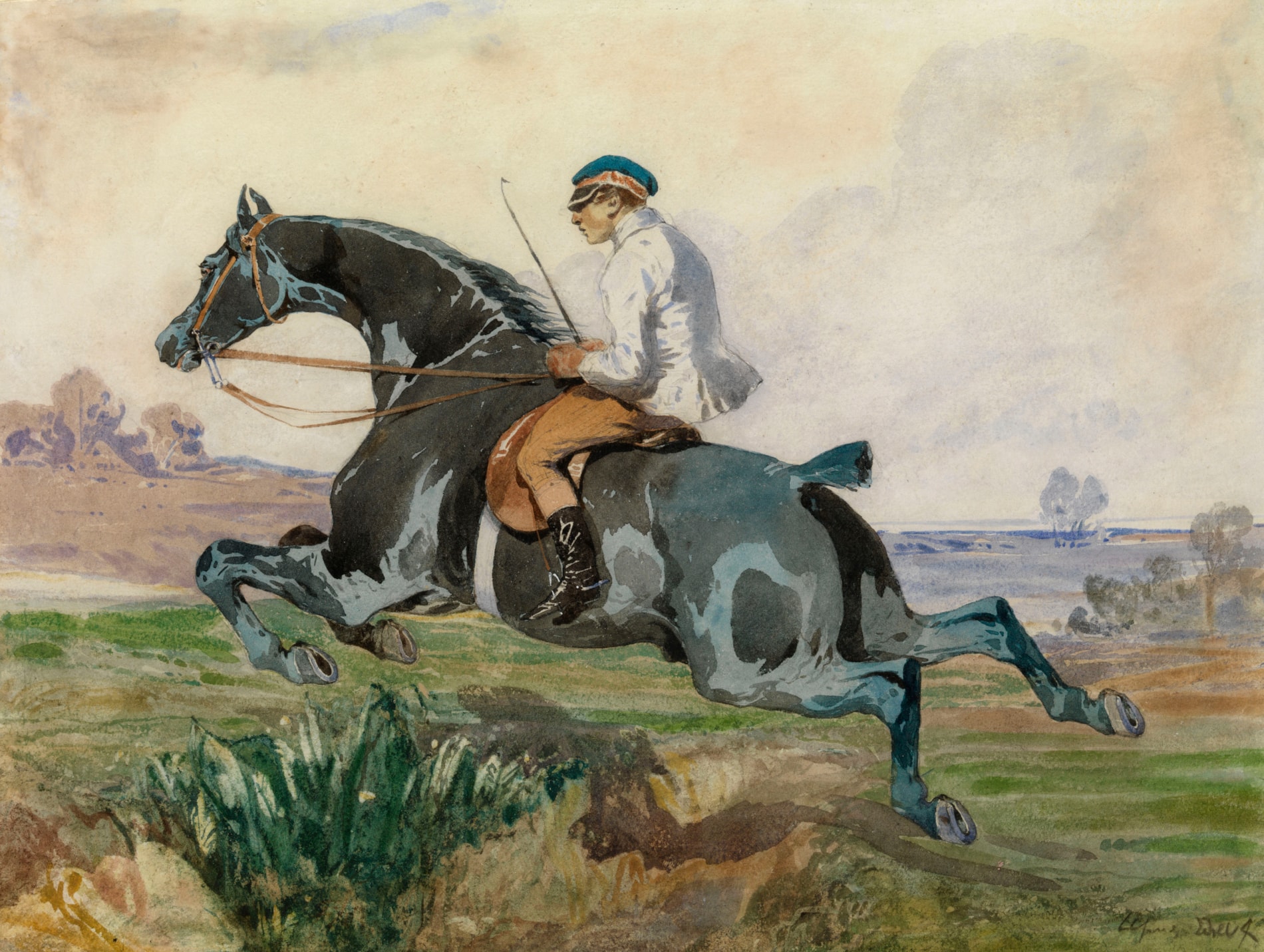Alfred DE DREUX
(Paris 1810 - Paris 1860)
The Jockey
Sold
Watercolour.
Signed Alfred de Dreux at the lower right.
279 x 375 mm. (11 x 14 3/4 in.)
Signed Alfred de Dreux at the lower right.
279 x 375 mm. (11 x 14 3/4 in.)
De Dreux’s depictions of horses were much admired by his contemporaries, who saw him as the natural heir to Géricault. As one critic noted in 1834, a painting of a horse by De Dreux ‘would perhaps support the comparison, in terms of its energy, its verve and its truth, with the horses of Géricault.’ In later years, Edgar Degas is known to have copied prints of horses by both De Dreux and Géricault in preparation for his own racetrack paintings.
This is a splendid, fresh example of De Dreux’s watercolour technique. Indeed, as has been noted of this drawing, ‘In its crispness and vigour the watercolour is typical of the best of Dedreux’s works.’ A related study in pen and brown ink of this composition, of similar dimensions, was exhibited alongside the present sheet in 19754, and is turn a study for a lithograph published in 1842.
This is a splendid, fresh example of De Dreux’s watercolour technique. Indeed, as has been noted of this drawing, ‘In its crispness and vigour the watercolour is typical of the best of Dedreux’s works.’ A related study in pen and brown ink of this composition, of similar dimensions, was exhibited alongside the present sheet in 19754, and is turn a study for a lithograph published in 1842.
As a youth, Alfred De Dreux was taken by his uncle, the painter Pierre-Joseph Dedreux-Dorcy, on frequent visits to the studio of his friend Théodore Géricault. The important and formative influence of Géricault on the young De Dreux can be seen not only in the Romantic nature of his early paintings, such as the Nègre à cheval in the Vaudoyer collection, but also his lifelong fascination with equestrian subjects. After studying with Léon Cogniet, De Dreux exhibited two paintings – a Cheval sautant un fossé and an Intérieur d'écurie - at the Salon of 1831, to much acclaim. In 1833 he was commissioned to paint an equestrian portrait of the Duc d'Orléans, and by the following year was already being described by one critic as, together with Carle Vernet, ‘le meilleur peintre de chevaux de l’époque romantique.’ In 1840 he began a series of paintings entitled Portraits de chevaux, which included several depictions of horses owned by the Duc d'Orléans.
Alfred De Dreux’s depictions of horses were much admired by his contemporaries, who saw him as the natural heir to Géricault. As one critic noted in 1834, a painting of a horse by De Dreux ‘would perhaps support the comparison, in terms of its energy, its verve and its truth, with the horses of Géricault.’ In later years, Edgar Degas is known to have copied prints of horses by both De Dreux and Géricault in preparation for his own racetrack paintings.
De Dreux reached the height of his fashionable success during the reigns of Louis-Philippe and Napoleon III, and even won a commission from Queen Victoria, whom he painted riding in Windsor Park alongside the French King. (He also met Victoria’s favourite painter, Sir Edwin Landseer, who inspired him to paint dogs.) His fame was further enhanced by the lithographs after his works which were published in France, Germany, England and America. Following the abdication of Louis-Philippe in 1848, De Dreux accompanied him into exile in England. He eventually returned to France, but visited London often in later years. He received several commissions from members of the English aristocracy, for whom his paintings reflected their passion for horses, hounds and hunting. De Dreux continued to paint equestrian portraits, hunting and racing scenes throughout the Second Empire, many of which were exhibited at the Paris Salons, as well as at the Exposition Universelle of 1855. His death in 1859 remains somewhat mysterious, but was apparently the result of a duel fought over a painting.
Alfred De Dreux’s depictions of horses were much admired by his contemporaries, who saw him as the natural heir to Géricault. As one critic noted in 1834, a painting of a horse by De Dreux ‘would perhaps support the comparison, in terms of its energy, its verve and its truth, with the horses of Géricault.’ In later years, Edgar Degas is known to have copied prints of horses by both De Dreux and Géricault in preparation for his own racetrack paintings.
De Dreux reached the height of his fashionable success during the reigns of Louis-Philippe and Napoleon III, and even won a commission from Queen Victoria, whom he painted riding in Windsor Park alongside the French King. (He also met Victoria’s favourite painter, Sir Edwin Landseer, who inspired him to paint dogs.) His fame was further enhanced by the lithographs after his works which were published in France, Germany, England and America. Following the abdication of Louis-Philippe in 1848, De Dreux accompanied him into exile in England. He eventually returned to France, but visited London often in later years. He received several commissions from members of the English aristocracy, for whom his paintings reflected their passion for horses, hounds and hunting. De Dreux continued to paint equestrian portraits, hunting and racing scenes throughout the Second Empire, many of which were exhibited at the Paris Salons, as well as at the Exposition Universelle of 1855. His death in 1859 remains somewhat mysterious, but was apparently the result of a duel fought over a painting.
Provenance
P. & D. Colnaghi, London, in 1975
Robert Noortman Gallery, London, in 1977
J. L. W. Bird Fine Art, London, in 1983
Peter Gilbert Greenall, Baron Daresbury of Walton, until 2011.
Literature
London, P. & D. Colnaghi, French Drawings: Post Neo-Classicism, exhibition catalogue, 1975, unpaginated, no.50 (‘In its crispness and vigour the watercolour is typical of the best of Dedreux’s works.’)





